
USA & CANADA (847)
Latest News
Ivana carried in gold casket as Trump family arrives at funeral (photos)
Saturday, 23 July 2022 14:07 Written by lindaikejiblog 
The funeral for Ivana Trump, former wife of Donald Trump, is underway.
Donald Trump, his current wife Melania Trump, their child Barron, Trump’s children with Ivana and grandchildren were present at the funeral in Manhattan Wednesday, July 20.

"She had brains; she had beauty," her son Eric Trump said in a speech at the St. Vincent Ferrer Catholic Church on the Upper East Side.
"She was the embodiment of the American dream … She was a force of nature," he told mourners.
He said his mom, a former model and onetime professional skier, "could beat any man down the slopes, any woman on the runway."

Donald Trump Jr. was also in attendance, and his teenage daughter Kai Trump gave a speech remembering her beloved grandmother.
Ivanka Trump gave a speech describing her mom as a tough-as-nails trailblazer in the business world.

Ivanka said: "Growing up, my mother didn’t tell me a woman could do anything she wanted to — she showed me.
"She was a trail blazer by men and women alike.

"My mother once told me there was nothing she couldn’t do in heels. She taught us how to spear fish and then cook what we caught."

She added, "My mom expanded our minds."
Ivana, 73, died from a fall at her home on July 14, 2022.

July 4 Highland Park shooter tried to kill himself 'multiple times' because he was a loner whose relatives ignored -Family friend claims
Sunday, 10 July 2022 13:15 Written by lindaikejiblog 
New details from former friends and parents have now revealed how 21-year-old Bobby Crimo, had attempted suicide multiple times in 2016 and 2017 and had threatened to overdose because he was a loner whose relatives didn't care for.
On July 4, 2022, Crimo carried out a mass shooting during an Independence Day parade in Highland Park, Illinois, United States. The shooting occurred at 10:14 a.m roughly 15 minutes after the parade had started. Seven people died, and 46 others were wounded by gunfire or injured in the ensuing panic. Crimo was arrested and charged to court.
People who knew Crimo in the past have now revealed that he was a lonely child who experienced a 'downward spiral,' had attempted suicide and talked about overdosing.
A mother of two of Crimo's skatepark friends, who asked to remain anonymous, said the 21-year-old used to come to her home often in 2016 and 2017.

Crimo's Parents
She also said Crimo had threatened and attempted to kill himself a few times while he was hanging out with her kids and that he struggled with self-harm and suicidal thoughts as early as 2016.
She described the then-boy as polite and quiet and would have 'never guessed that he would hurt a fly.'
'Hurt himself? Yes. But hurt someone else? No,' the mom told the Daily Beast. 'He was a sweet kid, but he hurt. He was very, very much a loner and depressed. And I think his emotional instability was kind of brushed under the rug by his family.'
Another friend of Crimo reportedly messaged his father on Facebook in 2015 after he said 'some concerning things' about overdosing, she told the Beast. She also said Crimo Senior had blocked her on Facebook.
Crimo posted several music videos under the alias Awake the Rapper. One of his videos, show a depiction of a shooting being gunned down police. Another showed him inside a classroom, draped in the American flag, and wearing tactical gear.
He also reportedly had a Discord channel, which has since been disabled, where he posted a beheading video and reportedly interacted with a devoted to death message board, according to NBC New York.

Crimo's parents' attorney George Gomez told the Beast he was 'not aware' of 'anything like that happening in 2016.' He also said they 'didn't follow' their son on social media and did not know that he was a rapper..
Now, the anonymous mother is wondering how Crimo's parents were able to say there was nothing wrong with their child, as she said there were many warning signs.
'I thought it was a joke when his uncle came out and said: "There were no signs of this. He was always this quiet kid, working in his apartment and behind the house." When it was like he had tried killing himself twice when he was hanging out with my [children], so how could you say there was no signs of this?'
Crimo's father even sponsored a gun permit application, despite the 2019 police reports indicating he had tried to kill himself and in a separate occasion, threatened to kill his family. Gomez said the father had arrived home after police had arrived in 2019.
'I think there’s a lot of balls dropped, no matter which way you look at it, the mother said. 'Parents, the government itself. I mean, if what they are saying is true on the report that happened back in 2019, why would his father sponsor him to legally purchase these guns?'
Weeks later, another mutual friend would go over to Crimo's house and voice concern as well, the friend told the Daily Beast.
'He felt a lot of times that his parents didn’t care about him,' the friend told the Beast.
'From what it sounded like, his parents worked a lot,' the friend told the outlet. 'If they weren’t home, they were working, and when they were home, they were resting or sleeping. So Bobby was always out doing his own thing.
'He felt alone and misunderstood. He said a couple of times he wished he was like other kids. He was, but he didn’t think so,' they said.
An April 2019 police report, obtained by the Daily Beast, showed police had performed a welfare check on Crimo and had reported he had attempted to 'commit suicide by machete' and was 'known to use marijuana.'
In September 2019, police turned up again to the Highland Park residence and a police report allegedly stated he had threatened to kill his whole family.
Police confiscated 16 knives, a 12-inch dagger and a 24-inch samurai sword during the wellness check, according to the report, but returned them to Crimo's father, who claimed they were his, which is one of the reasons why, police officers said, the young shooter passed the Red Flag law, a law which stops people flagged by police from buying guns.
Even though, as the documents show, Crimo was deemed a 'clear and present danger,' who, 'if granted access to a firearm or firearm ammunition poses an actual, imminent threat of substantial bodily harm to themselves or another person[s] that is articulable and significant or who will likely act in a manner dangerous to the public interest.'
Police also reportedly filed a 'clear and present danger' foam with the Illinois State Police. State police would later determine that Crimo did not meet the criteria to be considered a danger.
Despite the incident, Crimo's father helped him apply for a firearm owner identification card (FOID) mere weeks later, and Crimo passed four Illinois background checks to purchase the gun he would go on to murder seven people with three years later.
Crimo's attorney, Steve Greenberg, told Fox 32 that the process was 'no different than signing up your kid for driver's ed.'
'He bought everything on his own, and they’re registered to him,' the elder Crimo told the New York Post. 'You know, he drove there, he ordered them, he picked them up, they did his background check on each one.'
Another parent Michele Rebollar - whose late son was friends with Crimo also made similar statements.
'There’s no justification, he could have got help, he could have told somebody, but if you’ve never had somebody to tell, how do you even know who to tell, if no one’s ever been there for you?' she told the Beast.
She also said Crimo had spoken at her son's funeral and he no longer resembles the little kid who said her son had made him feel 'like I wasn’t alone anymore, like I had somebody there, like, that was actually there.'
Other court documents suggested that Crimo's parents weren't always thinking of his well-being, as one document said his mother had left her small son in a hot car for 27 minutes as a toddler. His mother was later convicted over the incident.
The disturbing 2002 incident was one of multiple brushes with the law Crimo's mom Denise Pesina and dad Bob Crimo Jr had with police prior to Monday's massacre in Chicago that killed seven.
The number of people who have died in the Highland Park Fourth of July massacre has risen to seven, as of Friday, July 8.
The victims include Stephen Straus, 88; Katherine Goldstein, 64; Jacki Sundheim, 63; Nicholas Toledo Zaragoza, 78; Eduardo Uvaldo, 69, and husband and wife, Irina and Kevin McCarthy, 35 and 37.
Robert Crimo, has been charged with seven counts of first-degree murder.
How Iceberg Alley got its name and why it may be under threat
Tuesday, 21 June 2022 01:27 Written by theconversation 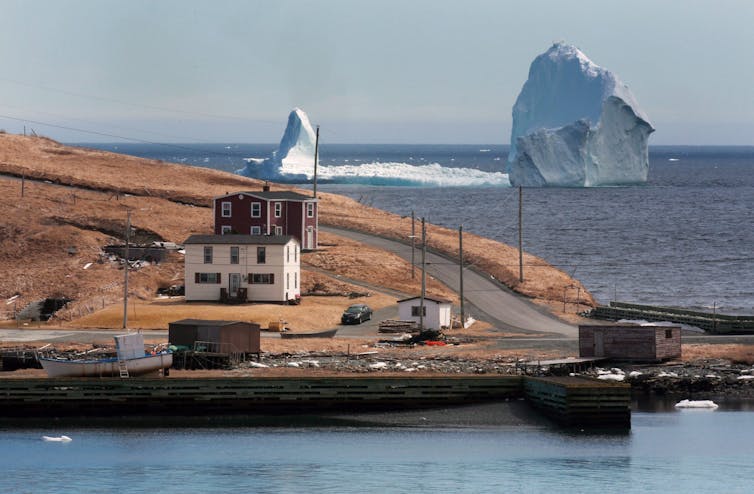
Frédéric Cyr, Memorial University of Newfoundland
Iceberg Alley, the stretch of coast ranging from Labrador to Newfoundland, is the southernmost region of the northern hemisphere where one can regularly see icebergs. But hurry up! As the planet continues to warm, Iceberg Alley may soon lose its name.
Iceberg sightseeing is a common — and much-anticipated — activity in Newfoundland. Every spring, locals and visitors brave the region’s damp and chilly weather — it’s one of the foggiest places on the planet — to scrutinize the horizon for large white objects or embark on boat tours, hoping that luck will be on their side.
But with iceberg counts ranging from zero to more than 2,000 per year, booking a trip in advance to see these 10,000-year-old blocks of ice can be a gamble.
10,000-year-old ice
Every year, hundreds of billions of tonnes of ice, equivalent to more than 100 million Olympic pools of water, once melted, is shed from Greenland’s glaciers into the ocean. This phenomenon is called calving.
The bulk of the ice calving from Greenland’s glaciers form icebergs. While about 10-50 per cent of these icebergs melt directly in Greenland’s fjords, the majority are carried away by ocean currents.
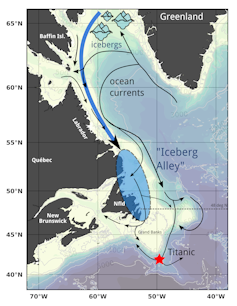
The Greenland ice sheet is the result of thousands of years of snow accumulation that has reached a thickness of more than one kilometre. The pressure that comes from the enormous weight transforms the snow into ice. The same pressure pushes the glaciers — rivers of ice funnelled by numerous fjords — towards the ocean where they calve and form icebergs.
A subset of these icebergs, mostly originating from the west coast of Greenland, will reach Newfoundland. While these icebergs can live for as long as a decade, those reaching Newfoundland are generally one to two years old.
Sinking of the Titanic
The most famous of these icebergs is probably the one that sank the Titanic just south of the tip of the Grand Banks of Newfoundland in 1912. That year was not an abnormal one for icebergs, with 1,038 icebergs reported. Following this tragedy, in 1913, the International Ice Patrol, operated by the U.S. Coast Guard on behalf of several maritime nations, was created to monitor iceberg dangers for ships in the North Atlantic.
The International Ice Patrol’s annual count of the number of icebergs that slip south of 48 degrees north provides the longest and most reliable time series of icebergs in Newfoundland. In an average year, nearly 800 icebergs are expected to cross the boundary, which lies just north of the Grand Banks of Newfoundland.
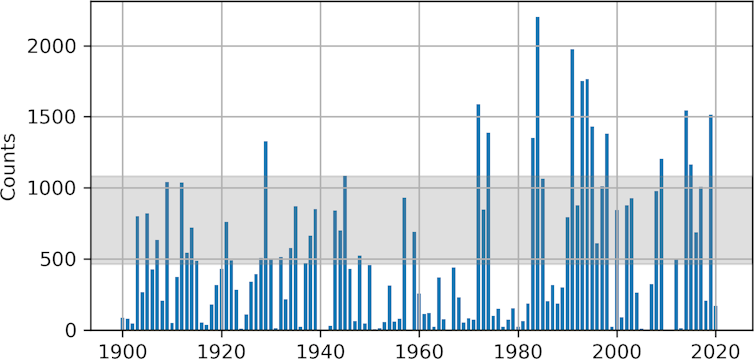
These annual counts are extremely variable and affected by the climate of the North Atlantic. The 1980s and ‘90s were an especially cold period in the region, and more than 1,500 icebergs were observed during some of those years, with a record high of 2,202 in 1984. More recently, 1,515 icebergs were spotted in 2019, a year characterized with colder than normal spring temperatures and immediately following another cold period in the mid-2010s.
But these numbers decrease drastically during years characterized by milder winters and an early spring. This occurred in 2010 and 2021, where only one iceberg was observed; in 2011, which saw two icebergs; and in 2013, where 13 icebergs were recorded. Only two years, 1966 and 2006, in the 122-year time series have reported no icebergs journeying south of 48 degrees north.
An uncertain future
With the planet warming up as a result of anthropogenic climate change, the Greenland ice sheet is losing mass. While this may suggest that more icebergs will calve into the ocean, it is far from guaranteed that this will lead to more sightseeing opportunities in Newfoundland. And the numbers may lie, as improvements in iceberg-detecting technology may be responsible for an apparent upward trend in counts.

The environmental parameters that control the number of icebergs in Newfoundland in a given year remain unclear. However, it appears that a warmer climate definitely leads to fewer or simply no icebergs at all in Newfoundland.
For example, when looking at the region’s three warmest years on record — 1966, 2010 and 2021 — only zero, one and one icebergs were reported. These outliers may well become the new norm as climate projections suggest with a high level of confidence that the frequency and severity of extreme events, such as an anomalously warm year, will increase in the future.
While the Newfoundland iceberg sightseeing tourism industry may well have benefited from a succession of exceptional iceberg seasons linked to a recent rebound in cold ocean conditions in the mid-2010s, its future is less certain.
Will the Iceberg Alley lose its name? It would be unfortunate, but it is possible. For the moment there is still time to enjoy these 10,000-year-old remnants of the past. So hurry up before it’s too late!![]()
Frédéric Cyr, Adjunct professor, Physical Oceanography, Memorial University of Newfoundland
This article is republished from The Conversation under a Creative Commons license. Read the original article.
How the slow-burning housing crisis is driving hunger in Canada
Tuesday, 21 June 2022 00:41 Written by theconversation
Charlotte Spring, Wilfrid Laurier University and Audrey Tung, University of Victoria
Canada’s housing crisis is constantly in the news: sky-high prices, mixed with high levels of inflation and household debt, is a recipe for disaster. Inflation is also impacting food prices, and as wages remain stagnant food insecurity appears to be on the rise.
While both housing affordability and food insecurity are spoken about often, we rarely hear about whether, and how, they are connected.
One of us (Charlotte), was recently part of a team that conducted a review of research exploring the “housing-food insecurity nexus” in Canada. It asked whether considering housing and food together could yield more comprehensive solutions than simply building more housing, or increasing food charity supplies.
The ‘housing-food insecurity nexus’
The team reviewed research addressing relationships between housing and food insecurity between 2000 and 2020. This helped define the housing-food insecurity nexus as the “co-occurrence of housing and food insecurity, often resulting from unaffordable housing costs (and the relative flexibility of food expenditure) in the context of neoliberal housing policy and market conditions where living costs outstrip incomes for many.”
We found that due to the fixed pressure of housing costs and relative flexibility of food spending, many low-income people choose to go hungry rather than risk eviction.
This has followed funding cuts for non-market housing, prioritization of homeownership at the expense of renters, financialization and incomes that fail to meet basic living costs.
And while access to decent housing and food are fundamental human rights and key social determinants of health, they are more often framed and treated as commodities.
Demographic risk factors
Throughout our review, we found research that consistently identified particular groups to be at greater vulnerability to both housing and food insecurity. These include renters, people living with disabilities or HIV, youth, students, women — especially single mothers — and racialized people.
A 2016 Vancouver study showed that 64 per cent of unhoused people were experiencing food insecurity. Negative health outcomes were compounded by mental health struggles, substance misuse and risky behaviours to acquire food.
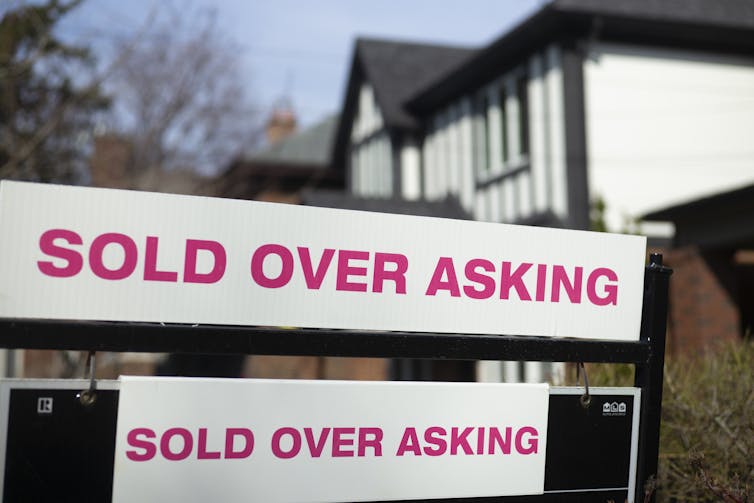
Demographic risk factors as well as marginalization often overlap and intersect, making problems worse.
Some scholars describe this as “multiple material needs insecurities” that combine with societal stigma to produce variable experiences and vulnerability to the housing-food insecurity nexus.
As disadvantages related to gender, race, sexuality and other social categories accumulate over the course of one’s life. Housing and food insecurity often manifest in old age, despite the protections of universal pension payments. This is a time when individuals are least capable of participating in the labour market and navigating welfare and food services, yet remain overlooked by policymakers and service providers.
But are there solutions to the housing-food insecurity nexus?
Short-, medium- and long-term solutions
In the short-term, community-based initiatives can bring food and housing provisioning together. They can facilitate food growing, or spatial access to affordable food in temporary accommodation or social housing. For example, FoodShare Toronto partners with housing agencies to provide healthy and affordable food to low-income neighbourhoods.
And in the medium-term, better effort can be made to address intersecting policy drivers of the housing-food insecurity nexus through more collaborative governance. For example, a study in Peterborough, Ont., suggested how different levels of government can collaborate with housing providers, activists, researchers and community members to develop policy targeting housing and food together.
This can occur through food access planning in affordable housing developments (or, as in this Vancouver trial, in rapid housing initiatives that try to move unhoused people into permanent homes). Even within transitional and subsidized housing services, food and housing supports often fail to meet the diverse needs of residents, especially those who are most vulnerable.
In the long-term, prevention of the housing-food insecurity nexus requires more fundamental changes in the ways that basic needs, such as housing and food, are framed (as rights rather than commodities) and provided, by targeting both incomes and supply.
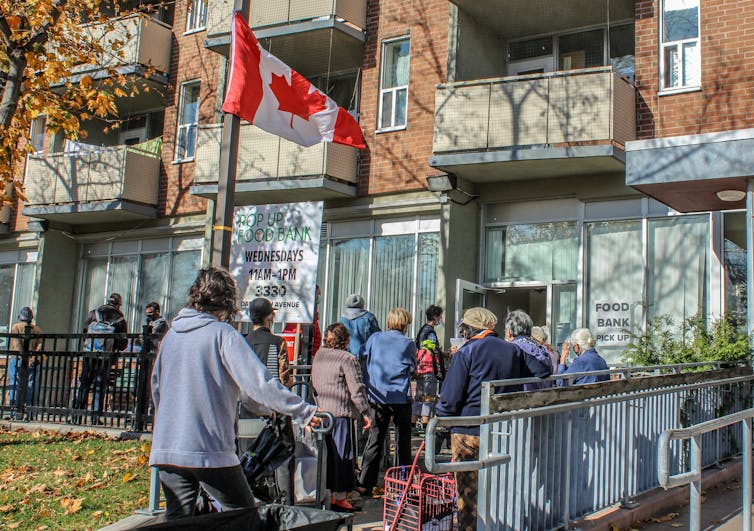
This involves first tackling the low wealth and inadequate incomes that result in people being unable to meet all of their basic needs. Benefits must meet rising rental costs and housing costs can’t rise above 30 per cent of incomes, as advocated by some food banks.
Additionally, policy can target supply-side proposals that might decommodify housing, protecting it from the financialization that is helping drive housing insecurity. Universal Basic Services, a policy concept originating in the United Kingdom, suggests that rather than targeting income alone, policies should ensure that everyone can access basic requirements, from housing to food, based not on their ability to pay, but on our shared universal need.
Although the pandemic has triggered historic federal, provincial and municipal re-investments in social programs (including affordable housing), it remains to be seen whether these interventions will reach people who are most vulnerable, and whether they will truly reverse a longstanding political climate of austerity.
Political will is the key ingredient to ensuring that secure housing and good food is something guaranteed to all.
Marit Rosol of the University of Calgary co-authored the housing-food insecurity nexus report.![]()
Charlotte Spring, Postdoctoral Research Associate, Laurier Centre for Sustainable Food Systems, Wilfrid Laurier University and Audrey Tung, PhD Student, Geography, University of Victoria
This article is republished from The Conversation under a Creative Commons license. Read the original article.
Popular News
Ontario’s child-care agreement is poised to fail low-income children and families
Tuesday, 21 June 2022 00:39 Written by theconversation 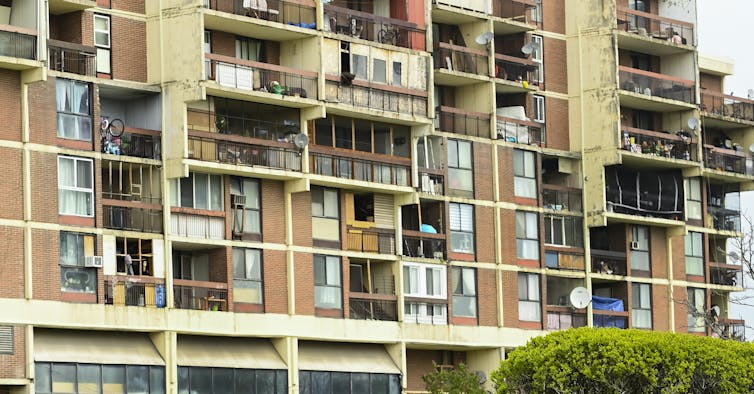
Petr Varmuza, University of Toronto; Linda A. White, University of Toronto, and Michal Perlman, University of Toronto
Many parents, economists and and child-care advocates celebrated the signing of Ontario’s early learning and child-care agreement with the federal government at the end of March.
The agreement means a substantial infusion of federal government funding to allow an immediate 25 per cent reduction of child-care fees, followed by a further reduction to 50 per cent at the end of 2022. A final reduction to an average of $10 per day is set to happen by 2026.
As researchers with combined expertise in public policy and its effectiveness, and applied psychology and human development and preschool-aged children, we believe universal access to early learning and child care should mean an equitable treatment of every child, where every child receives the support they need. But this isn’t the case with Ontario’s agreement.
Something that deserves scrutiny and redress is how Ontario’s new early learning and child-care deal creates inequities for children in the most economically disadvantaged families.
Issues with the agreement
Only a few days after Ontario’s agreement was signed, significant cracks began to emerge. Child-care researchers and advocates raised concerns about the agreement’s provisions that allow proportional expansion of the for-profit sector and the lack of commitment to living wages and benefits for child-care workers.
The proposed expansion of 86,000 spaces beyond the 2019 licensed capacity falls overwhelmingly short of the forecasted demand that will be generated by lower child-care fees.
Expert analysis suggests that as many as 200,000 additional licensed child-care spaces may be required as a result of demand spurred by halving parents’ child-care fees. By 2026, when the full fee reduction must be implemented, yet another 100,000 spaces may be required.
Every unique early learning and child-care agreement Canada has signed across the country leaves it up to provinces or territories to determine how the average $10 fee will achieved.
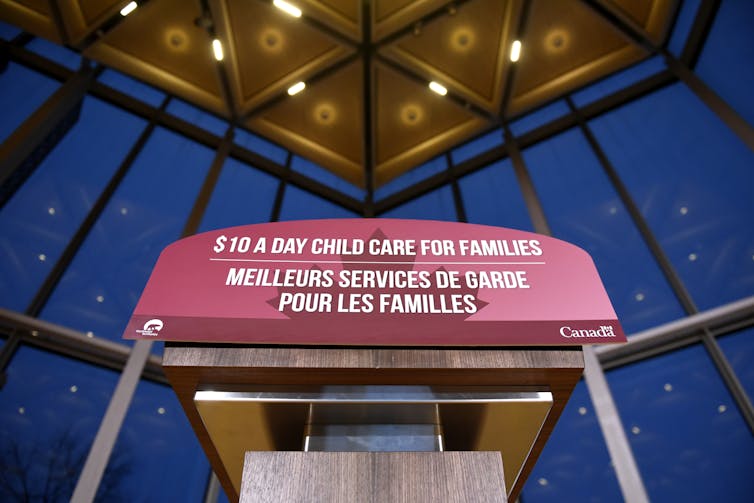
Subsidy rules
In Ontario, the agreement provides for the $10 provincial average to be created by the combination of a flat $12 fee combined with lower fees paid by families receiving child care subsidies. Those subsidies are subject to availability and aren’t guaranteed to every family who meets established social need criteria. Criteria include being employed, attending school or having a certified child or parent with a special need.
These conditions are reminiscent of Victorian-era attitudes that obscure the policy and systemic roots of poverty and which restrict state aid for the “deserving” poor — those who are considered gainfully employed, “productive” or working to improve their economic situations.
In Ontario, the amount of the financial subsidy is the difference between full fees and a family’s own contribution as determined by an income test defined by provincial regulation. The payment is calculated by excluding net taxable family income under $20,000, charging a 10 per cent of income between $20,000 and $40,000 and rising to 30 per cent for income above $40,000.
If a parent’s child-care provider agrees to participate in Ontario’s new early learning and child care agreement, 25 per cent fees parents have paid after April 1, 2022, would be retroactively refunded. The new rate would apply going forward. Providers have up to Sept. 1 to sign up.
For fully employed families, whether they pay full fees or receive a subsidy, the child-care cost may be further reduced by claiming the Child Care Expense Deduction and the Ontario Childcare and Affordable Relief from Expense tax credit.
Access isn’t universal
Ontario’s agreement thus creates a universal, flat-fee child care for medium and high-income families. Subject to limited funding availability, Ontario retains subsidized child-care for a portion of the subsidy eligible parents for low-income people under stringent conditions.
Higher-income families have no eligibility requirements or a maximum income cap to take advantage of the reduced child-care fees.
But for those low-income families who meet the subsidy eligibility criteria, access will become unfortunately harder: Ontario’s April 2022 provincial funding guidelines reduce transfers to municipalities for subsidy funding by 25 per cent. They also specifically prohibit the use of the new early learning and care agreement funding from increasing the number of subsidies, despite long waiting lists in many areas of Ontario.
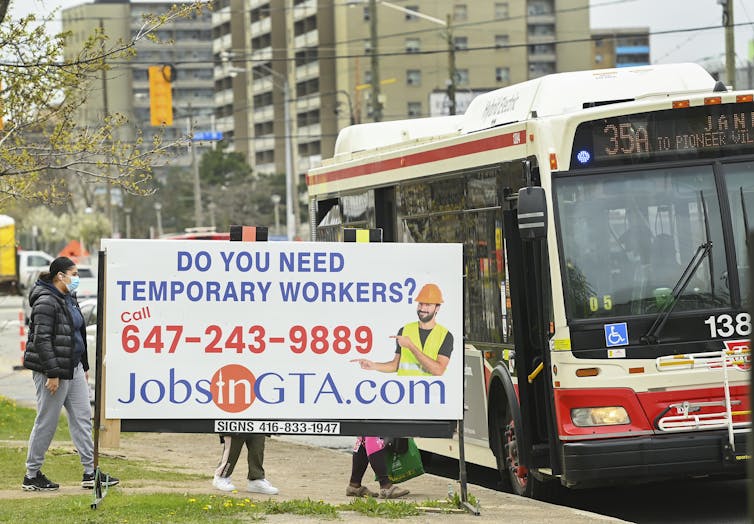
Many low-income families won’t be eligible
Decades of research demonstrates that the most disadvantaged children can benefit most from access to high-quality licensed child care.
The very tool that can improve the life chances and reduce the inter-generational transfer of poverty is, by the Ontario government’s exclusionary policy, systemically less available to many of the most disadvantaged children.
There is substantial international and Canadian evidence that well-off families living in well-off communities have better access to better-quality child-care programs. Without attention to equitable access, universalization of child-care access leads to over-representation of children from relatively more affluent families. This can be seen in Québec’s experience with implementing what was launched as $5-a-day child care more than 20 years ago, as well as in the experience of several European Union member states.
Universal access should mean an equitable treatment of every child, where every child receives the support they need.

Next steps
In Ontario, the obvious next steps are the removal of the subsidy system’s restrictive eligibility criteria.
Ontario needs to introduce a guarantee access to full early learning and care experiences for children from low-income families. Right now, the $12 flat fee should be replaced by an income-tested fee reflecting family incomes. The income test mechanism should be flexible enough to meet the conditions of the new agreement.
Reducing the inequity gap should be at the top of agenda for implementation of the new early learning and care agreement. If this is not addressed, this policy direction will have consequences affecting the life chances of disadvantaged populations possibly for generations to come.![]()
Petr Varmuza, Assistant researcher, Perlman Lab, Ontario Institute for the Studies of Education, University of Toronto; Linda A. White, RBC Chair and Professor, Department of Political Science and Munk School of Global Affairs and Public Policy, University of Toronto, and Michal Perlman, Professor of Applied Psychology and Human Development, University of Toronto
This article is republished from The Conversation under a Creative Commons license. Read the original article.
Social assistance cuts are contributing to high rates of HIV, syphilis in Saskatchewan
Wednesday, 15 June 2022 00:54 Written by theconversation 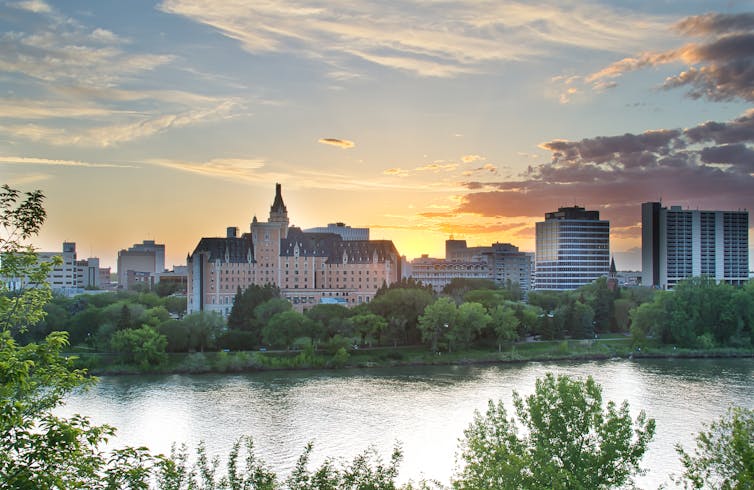
Alana Cattapan, University of Waterloo and Holly Ann McKenzie, University of Saskatchewan
The province of Saskatchewan leads the country in preventable, opportunistic illnesses enabled by poverty. With new changes to income support programs and increased housing instability, things are getting worse.
Saskatchewan has the highest rate of HIV in Canada, with cases more than three times the national average. New cases are occurring via what’s known as vertical transmission (from mother to child), largely unseen in wealthier nations because such cases are preventable with the use of anti-retroviral drugs.
Injection drug use is the most common mode of transmission in the province, and the numbers are highest among Indigenous people where ongoing legacies of colonialism, policy-induced poverty, intergenerational trauma and substance use are woven together.
Indigenous people have met these challenging conditions with resistance, mobilizing Indigenous-led responses to HIV and advancing Indigenous ways of knowing. But these efforts continue to be undermined by limited funding and provincial government failures to provide sufficient income assistance for those living in economic precarity.
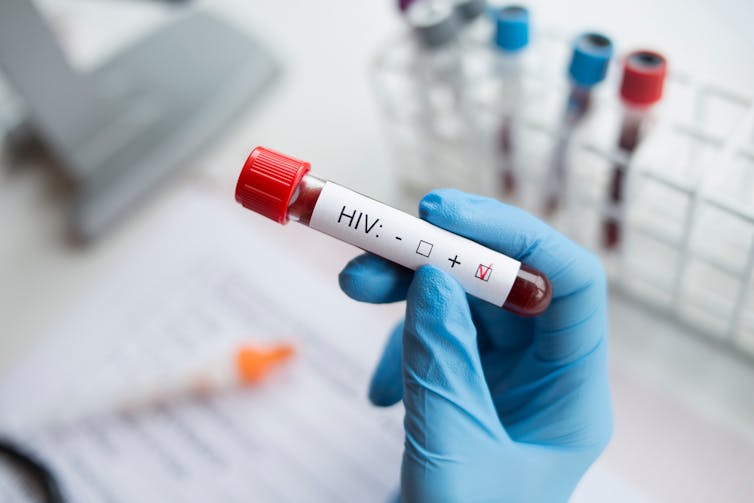
Syphilis epidemic
Increasing HIV rates in Saskatchewan are occurring alongside a new epidemic of syphilis.
This is not surprising, because syphilis increases susceptibility to HIV; it’s a harbinger of more HIV infections to come. Syphilis cases are increasing exponentially, to more than 800 cases in 2021, from five cases in 2016. The disease is extremely infectious in its less severe early stages and can, like HIV, be transmitted in pregnancy.
When transmitted in pregnancy (congenital syphilis), syphilis can have dire consequences, including stillbirth and babies born with a range of health issues, among them skeletal and facial anomalies, deafness, blindness and significant neurological problems. In 2016, there were four cases of congenital syphilis in Saskatchewan; four years later there were more than 50.

Both HIV and syphilis are opportunistic infections made more likely by the realities of living in poverty. They are both asymptomatic in their early stages, so people may not know they’re infected. The stress of poverty and substance use can contribute to people engaging in more HIV- and syphilis-risk behaviours than they might otherwise.
Once infected, both syphilis and HIV can be treated, but treatment can be intense — syphilis during pregnancy can require multiple appointments and HIV requires daily medication. When people are living without reliable housing and existing on insufficient income, they have to come up with creative strategies to survive and being screened, tested or treated for new infections is not always a top priority.
Benefits reduced
Inadequate rates of social assistance in Saskatchewan have long contributed to the problem, now exacerbated by changes that have recently reduced the total amount of benefits.
Unlike its predecessor, the new program does not fund the actual cost of utilities, instead providing an insufficient fixed amount. Other supports were reduced or eliminated, such as those for clothing, furniture and school supplies.

The new program also got rid of direct payment to landlords, which previously ensured that no matter what, rent was always paid. These changes have meant that more people than ever are being evicted, with the Saskatchewan Landlord Association reporting that 30 per cent of people on social assistance did not or could not pay their rent in the months after the change took effect.
In November 2021, the Ministry of Social Services stated it would pay rent and utilities directly for recipients who are at risk of homelessness, but housing organizations say this still isn’t happening.
More precarity, fewer resources
The increasing rates of syphilis and HIV are made worse by these changes to income assistance because people have more precarity and fewer resources than previously.
Although pregnant people and new parents often use various strategies to get what they and their children need to get by, their efforts are undermined by a fragmented system of care, lack of culturally responsive services and limited access to existing interventions. That includes screening and testing for asymptomatic, unidentified and/or untreated infections.
Providing adequate rates of social assistance is key to public health. We should need no other reason to ensure people have enough to live on than reducing the rates of entirely preventable, infectious diseases. But it also makes economic sense.
The costs of treating people who have contracted these diseases, and particularly children, cost substantially more over time than providing adequate social assistance. Slashing rates of social assistance is a costly mistake and the most marginalized pay the most dearly.
People living in poverty work hard to make ends meet and find creative strategies to make the most out of every dollar, but there is a limit. Without sufficient social assistance to meet people’s basic needs, more people are ending up in precarious circumstances, needing to access to more intensive and long-term interventions.
There is a vicious cycle in Saskatchewan of cutting public funding for social assistance to support people experiencing difficulty, only to intervene when things are much, much worse.![]()
Alana Cattapan, Assistant Professor, Department of Political Science, University of Waterloo and Holly Ann McKenzie, Postdoctoral Fellow, Medicine, University of Saskatchewan
This article is republished from The Conversation under a Creative Commons license. Read the original article.
Texas school shooting: How assault-style rifles and ammunition kill and maim
Monday, 06 June 2022 03:56 Written by theconversation 
R. Blake Brown, Saint Mary’s University
The recent mass shooting that killed 19 children and two teachers at Robb Elementary School in Uvalde, Texas, has sparked another round of the gun control debate.
The shooter reportedly used an AR-15-type rifle, bought just after he turned 18. The AR-15 has been controversial in the United States and Canada for decades, and, in 2020, Prime Minister Justin Trudeau’s government prohibited the weapon.
Assault-style rifle characteristics
Several characteristics of the AR-15 make it dangerous in the wrong hands. It is a semi-automatic firearm, meaning it can be fired repeatedly — once for each pull of the trigger. And it can be reloaded in seconds by removing its cartridge magazine and replacing it with a loaded one.
A less frequently commented upon feature of the AR-15 is that it usually fires a version of the ammunition used by many NATO soldiers to kill enemy troops. As shown in Texas, and many other mass shootings, that ammunition is also extremely effective at harming civilians. The Texas killer purchased 1,600 rounds of the ammunition.
Journalists have debated whether to detail the bodily harms experienced by mass shooting victims. Some believe that failing to describe the physical effects of rifle bullets sanitizes mass shooting events, and suggest that greater public knowledge about victims’ injuries might affect the gun control debate.
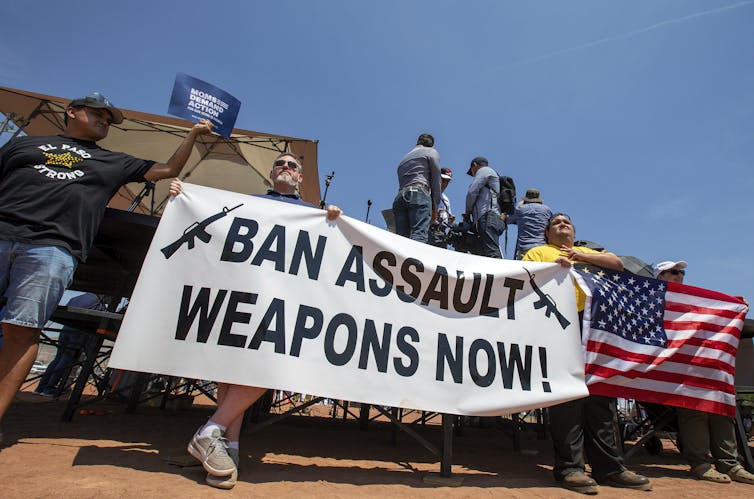
Dangerous high-velocity ammunition
Ammunition is often defined by its calibre — that is, by the diameter of the projectile fired. Firearm calibres are designated in millimetres or inches. The .223-inch calibre ammunition (or 5.56mm) used in most AR-15s is smaller than the rounds employed in many rifles traditionally used for hunting game, like the .308.
However, the small size of the .223 ammunition doesn’t mean it’s safe. It was developed in response to the American military’s desire in the post-Second World War period to create a small-calibre, high-velocity weapon. The .223 round was light, meaning that soldiers could easily carry many rounds for their rifles.
The firearms industry mass-marketed semi-automatic rifles like the AR-15, and such weapons became increasingly popular by the late 20th century. Unfortunately, rifles firing .223 ammunition also frequently became a favourite weapon of mass shooters.
Defenders of the AR-15 sometimes downplay the dangers of such guns. For example, in 2020, the vice-president of a Canadian gun lobby group, the Canadian Coalition for Firearm Rights, tweeted a picture of her AR-15 and called it a “a low-powered sport rifle.”
However, doctors who have treated the victims of mass casualty events have described the serious injuries inflicted by ammunition fired from assault-style rifles.
Graphic detail of injuries and damage
While gun advocates generally avoid discussing the harm that assault-style rifles can cause, there are exceptions.
Before he became
.Giltaca introduced his 2013 video, focused on wound characteristics, by stating that there was “some misconception about the .223 cartridge” and that he wanted to show “how dangerous that cartridge still is, even though, yes, it’s a small bullet.” He pointed out that unlike rounds fired from handguns, the “.223 travels really, really fast, and that creates some problems should you get hit with it.”
Giltaca detailed the various “problems” a human body experienced if shot with a .223 rifle bullet.
For example, he said the bullet produces a “little shockwave,” which leads to a “temporary stretch cavity.” If the bullet strikes a thigh, for example, “it’s going to suck a bunch of air in there.” This leads to “massive tissue disruption and tissue death” because “your skin has been pulled apart and it tears, and it collapses back together again.”
Giltaca concluded by offering his “bottom line.” Rifles firing ammunition like .223 rounds “are really, really dangerous,” for if “you get hit with a rifle round, you’re not coming back.”
Americans have been reminded of this over and over again in mass shootings committed with assault-style rifles. And, unfortunately, Canadians have also learned about the dangers of such guns.
The rifle used in the Montréal massacre in 1989, the now prohibited Mini-14, fired .223 ammunition. Fourteen young women died as a result.![]()
R. Blake Brown, Professor, History, Saint Mary’s University
This article is republished from The Conversation under a Creative Commons license. Read the original article.
4 reasons our gas and electricity prices are suddenly sky-high
Sunday, 05 June 2022 05:40 Written by theconversation 
Gas users and the incoming government are describing Australia’s sudden east coast energy crisis as “apocalyptic” and “a perfect storm”.
There is no doubt that a rare combination of international and domestic events, together with long-term policy shortcomings, have led to a very nasty position from which there is no easy way out.
Four events have led to the immediate crisis.
1. Coal-fired generators have been failing
First, outages at coal-fired power stations have meant that gas has been called on more than usual.
More than one quarter of coal-fired plants have been offline for much of the year so far, which is far from usual.
The system is designed so that when that happens, gas generators take their place.
2. Australia is running low on gas
Second, the Australian Energy Market Operator (AEMO) has been warning of gas supply shortages in the southeast for some time as traditional gas resources, mainly in offshore Victoria, run low.
Onshore gas development in Victoria has been prevented by a succession of state government decisions, and input terminals have been either rejected on environmental grounds or delayed due to financial barriers.
In 2012 the Gillard government rejected the idea of reserving a certain proportion for domestic consumption, as happens in Western Australia.
The history of cheap and plentiful gas in Victoria has made Victorian households and firms more dependent on gas than other Australians, and there has been little move towards electrification.
3. Europe wants non-Russian gas
Third, in their desperation to reduce their dependence on piped Russian gas, European countries have been pushing the international price of liquefied natural gas sky high, buying from countries such as Australia, Qatar and the United States.
Some Australian exporters have received prices four times or more times higher than normal.
4. Suddenly, there’s a cold snap
Finally, a cold snap on Australia’s east coast has brought forward the winter spike in demand for gas for heating.
The immediate impact of the combination of these four events has been a looming shortage of gas on the east coast, including gas to supply power stations.
Industrial gas consumers who do not have the protection of a fixed contract are facing potentially destructive prices.
Thankfully there is no immediate price impact for households using gas, as their retailers have gas supply contracts, although many households are suffering higher electricity prices because gas-fired power stations have had to be pushed into service to replace coal-fired stations.
Quick actions
AEMO has taken action, partly by imposing a wholesale price cap of $40 per gigajoule ahead of forecasts the spot price in Victoria was set to climb $382.
The “shadow price” used to indicate what would have happened were it not for the cap, hit $800 on Tuesday.
And AEMO has triggered the so-called Gas Supply Guarantee Mechanism to secure gas for power generators.
These actions have worked, even though a price of $40 per gigajoule is financially crippling for large industrial consumers, and AEMO cannot magically source gas that isn’t there.
But no overnight answer
Chris Bowen, the new minister for climate change and energy, is already working closely with AEMO and his state and territory counterparts and industry to get complete information and advice.
But as Treasurer Jim Chalmers said on Tuesday, there’s no overnight answer.
The Turnbull Government introduced the Australian Domestic Gas Security Mechanism in 2017 in response to concerns that exports of liquefied natural gas from Queensland might one day create domestic shortages.
It was also concerned that gas producers were selling gas overseas at lower prices than they were asking for at home. The threat of government intervention has generally ensured supply.
But the mechanism is unlikely to be effective in addressing the current problem, for two reasons. First, there are physical limits on getting gas awaiting export in Queensland to Victoria where it is needed.
And second, to the frustration of many gas customers, the mechanism can’t bring down prices, which are set internationally. It deals only with supply.
Thankfully, no false promises
The current crisis illustrates the fundamental policy connection between electricity supply, gas markets, and climate change.
The decision to immediately convene a meeting of the national energy and resources ministers and the relevant agencies is the right first step, but only the beginning of a journey that will involve urgent and sustained reforms to the way Australia’s markets work.
The new government has indeed come to power in the face of a perfect storm, and there are more challenges ahead. Its approach so far has been constructive, measured, and cooperative – and it has resisted the temptation to make promises it can’t keep.
It is to be hoped that this new approach will enable it to navigate through to what will almost certainly be somewhat calmer waters ahead.![]()
Tony Wood, Program Director, Energy, Grattan Institute
This article is republished from The Conversation under a Creative Commons license. Read the original article.






